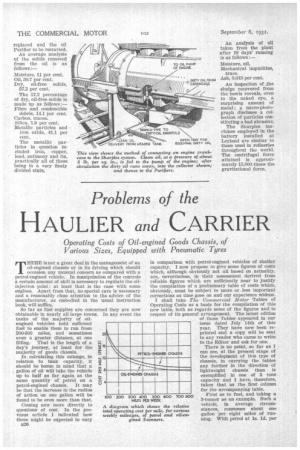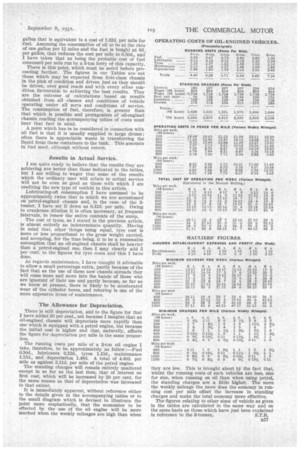Problems of the
Page 40

Page 41

If you've noticed an error in this article please click here to report it so we can fix it.
HAULIER and CARRIER THERE is not a great deal in the management of an oil-engined chassis or in its driving which should occasion any unusual concern as compared with a petrol-engined vehicle. In manipulation of the controls a certain amount of skill is necessary to regulate the oil
injection point; at least that is tile case with some engines. Apart from that, no special care is necessary and a reasonably close attention to the advice of the manufacturer, as embodied in the usual instruction book, will suffice.
In calculating this mileage, in relation to tank capacity, it should be borne in mind that a gallon of oil will take the vehicle up to half as far again as the same quantity of petrol on a petrol-engined chassis. It may be that the increase in the radius of action on one gallon will be found to be even more than that.
Coming now more directly to questionsof cost. In the previous article I indicated how these might be expected to vary
B26 in comparison with petrol-engined vehicles of similar capacity. I now propose to give some figures of costs which, although obviously not all based on actuality, are, nevertheless, in 'their assessment derived from reliable figures which are sufficiently near to justify the compilation of a preliminary table of costs which, obviously, must be subject to more or less important corrections as time goes on and our experience widens.
I shall take The Commercial Motor Tables of Operating Costs as a basis for the compilation of this new table, both as regards some of the figures and in respect of its general arrangement. The latest edition of these Tables appeared in our issue dated July 14th of this year. They have now been reprinted and a copy will be sent to any reader who cares to write to the Editor and ask for one.
There is no point, so far as I can see, at the present stage of the development of this type of chassis, in carrying the tables any farther in the direction of lightweight chassis than is exemplified in one of 3 tons capacity and I have, therefore, taken that as the first column for the accompanying table.
First as to fuel, and taking a 3-tonner as an example. Such a vehicle, in average circumstances, consumes about one gallon per eight miles of running. With petrol at is. ld. per gallon that is equivalent to a cost of 1.62d. per mile for fuel. Assuming the consumption of oil to be at the rate of one gallon per 12 miles and the fuel is bought at 6c1,, per gallon, that reduces the cost per mile to 0.50d., and I have taken that as being the probable cost of fuel consumed per mile run by a 3-ton lorry of this capacity.
There is this point, which must be noted before proceeding farther. The figures in our Tables are not those which may be expected from first-class chassis in the pink of condition and driven just as they should be driven, over good roads and with every other condition favourable to achieving the best results. They are the outcome of calculations based on results obtained from all classes and conditions of vehicle operating under all sorts and conditions of service. The consumption of fuel, therefore, is greater than that which is possible and protagonists of oilTengined chassis reading the accompanying tables of costs must bear that fact in mind.
A point which has to be considered in connection with oil fuel is that it is usually supplied in large drums; often there is appreciable waste in transferring the liquid from these containers to the tank. This amounts to fuel used, although without return.
Results in Actual Service.
I am quite ready to believe that the results they are achieving are better than those indicated in the tables, but I am willing to wager that some of the results which the ordinary user will attain in actual service will not be even so good as those with which I am crediting the new type of vehicle in this article.
Lubricating-oil consumption I have assumed to be approximately twice that to which we are accustomed on petrol-engined chassis and, in the case of the 3tonner, I have set it down as 0.12d. per mile. Owing to crankcase dilution it is often necessary, at frequent intervals, to renew the entire contents of the sump.
The cost of tyres, as I stated in the previous article, is almost entirely an indeterminate quantity. Having in mind that, other things being equal, tyre cost is more or less proportional to the gross weight carried, and accepting, for the time being, it to be a reasonable assumption that an oil-engined chassis shall be heavier than a petrol-enginecl one, then I may clearly add 5 per cent, to the figures for tyre costs and this I have done.
As regards maintenance, I have thought it advisable to allow a small percentage extra, partly because of the fact that as the use of these new chassis spreads they will come more and more into the hands of those who are ignorant of their use and partly because, so far as we know at present, there is likely to be accelerated wear of the cylinder bores, and reboring is one of the more expensive items of maintenance.
The Allowance for Depreciation.
There is still depreciation, and to the figure for that I have added 20 per cent., not because I imagine that an oil-engined chassis will depreciate more rapidly than one which is equipped with a petrol engine, but because the initial cost is higher and that, naturally, affects the figure for depreciation per mile in the same proportion.
The running costs per mile of a 3-ton oil engine I take, therefore, to be approximately as follow :-Fuel • 0.50d., lubricants 0.12d., tyres 1.15d., maintenance 1.15d., and depreciation I.48d. A total of 4.40d. per mile as against 5.11d. per mile of the petrol engine.
The standing charges will remain entirely unaltered except in so far as the last item, that of interest on first cost, which will be increased by 20 per cent, for the same reason as that of depreciation was increased to that extent.
It is immediately apparent, without reference either to the details given in the accompanying tables or to the small diagram which is devised to illustrate the point more emphatically, that the economies to be effected by the use of the oil engine will be more marked when the weekly mileages are high than when they are low. This is brought about by the fact that, whilst the running costs of such vehicles are less, size for size, when running on oil than when using petrol, the standing charges are a little higher. The more the weekly mileage the more does the economy in running cost per mile offset the increase in standing charges and make the total economy more effective. The figures relating to other sizes of vehicle as given in the tables are calculated in the same way and on the same basis as those which have just been explained
in reference to the 3-tonner5 S.T.R.




























































































